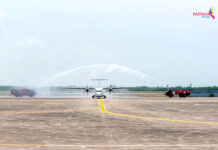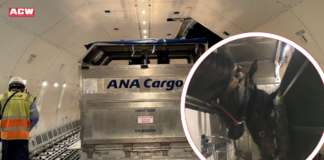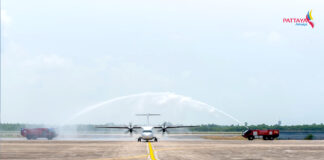

Qantas Freight reported what the Australian airline describes as a, “record underlying EBIT [earnings before interest and tax] of $114 million [Australian dollars], compared with $24 million in [fiscal year] 2014,” when it announced its full year results for the 12 months ending 30 June.
While the Qantas group says it made 975 million Australian dollars ($715.6 million) in profit before tax during the year. It explains that the, “underlying result,” is a turnaround of 1.6 billion Australian dollars compared with the financial year 2014 and, “Qantas’ best ever second half performance”.
Qantas Freight’s sister airlines are, Qantas, the low-cost carrier, Jetstar, the regional airline, QantasLink and the charter airline, Network Aviation.
For Qantas Freight, its parent airline says that its other successes include, the renewal of Australia Post as its biggest domestic freight customer and adding the new customer, Toll Group. Earlier this year, Qantas was informed by the Hong Kong authorities that Jetstar Hong Kong would not get a licence. This has brought Qantas’ interest in the airline to a halt. In his results speech, Qantas chief executive, Alan Joyce, says: “Qantas has written off its minority stake in Jetstar Hong Kong, with an impact of 21 million [Australian dollars], following the Hong Kong regulator’s decision not to approve the airline’s operating license. Qantas will make no further investment in Jetstar Hong Kong.”
However, Qantas is investing more in the Boeing 787-9 Dreamliner. It will join the Qantas international fleet from 2017. Qantas will buy eight 787-9 to replace five of its older Boeing 747, “and open up a range of potential new city pairs”. Four 787-9s will arrive in the airline’s 2018 financial year and four will arrive in the following fiscal year. “This will leave the Qantas Group with its six youngest reconfigured [Boeing] 747,” says the airline.
As well as the eight firm 787-9 orders, Qantas will retain 15 further options and 30 purchase rights for additional 787, with what is says is: “significant flexibility over the timing of delivery.”
Joyce, says: “This milestone acquisition marks the scale of our turnaround and looks ahead to a new era for our iconic international airline.” Qantas has been undergoing a transformation programme, as its management calls it, to bring the airline back into profitability and a sustainable economic future.
Joyce adds: “We’re halfway through the biggest and fastest transformation in our history. Qantas is rapidly growing fitter, stronger, and smarter.
“These [Boeing 787] aircraft are a fitting emblem of that evolution, they show that we are revitalised and here for the long haul.”
Joyce and his team’s expectations for Qantas are a capacity increase of up to four per cent in the first half of the next financial year for 2016. That capacity increase will come from new routes and the introduction of the Boeing 787-8, before the 787-9 enters service. In his speech, Joyce says: “We said we needed to pay down one billion [Australian dollars] in net debt, and we’ve done that.”










